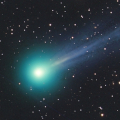
|
Now it is 7.3 mag (Sept. 23, Osamu Miyazaki). It brightens up to 4 mag, but it will turn to fade out rapidly after that. In the Northern Hemisphere, it will be getting lower gradually after this, and it will be unobservable in November. In the Southern Hemisphere, it is not observable now, but it will appear in December.
Date(TT) R.A. (2000) Decl. Delta r Elong. m1 Best Time(A, h)
Sept.27 9 13.22 38 21.1 1.180 1.062 57 7.6 4:27 (246, 38)
Oct. 4 9 59.85 40 58.3 0.948 0.946 58 6.6 4:33 (242, 37)
|
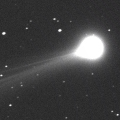
|
Bright new comet. Now it is 6.6 mag (Sept. 23, Chris Wyatt). It will fade out rapidly after this. In the Northern Hemisphere, it will be observable in October. In the Southern Hemisphere, it will be getting higher gradually.
Date(TT) R.A. (2000) Decl. Delta r Elong. m1 Best Time(A, h)
Sept.27 14 18.16 -14 4.8 0.578 0.608 33 6.6 19:14 ( 72, 0)
Oct. 4 15 5.65 -15 43.6 0.436 0.708 37 6.7 19:03 ( 66, 5)
|

|
Now it is 10.6 mag (Sept. 16, Thomas Lehmann). It brightens up to 7.5 mag, but it will turn to fade out rapidly after that. In the Northern Hemisphere, it is not observable now, but it will appear in October. In the Southern Hemisphere, it will be unobservable in October.
Date(TT) R.A. (2000) Decl. Delta r Elong. m1 Best Time(A, h)
Sept.27 13 22.51 -14 12.2 1.233 0.469 21 8.9 19:14 ( 81,-12)
Oct. 4 12 54.60 -13 50.3 1.295 0.359 10 7.8 19:03 ( 87,-21)
|
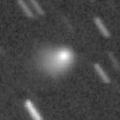
|
It is expected to brighten up to 5 mag in January. Now it is 13.1 mag (Sept. 21, Seiichi Yoshida). It will brighten rapidly after this. It will be unobservable in October in the Southern Hemisphere, or in December in the Northern Hemisphere. But it will be observable again in January in the Southern Hemisphere.
Date(TT) R.A. (2000) Decl. Delta r Elong. m1 Best Time(A, h)
Sept.27 16 7.98 24 57.3 2.461 2.187 62 12.4 19:14 ( 92, 44)
Oct. 4 16 14.06 21 39.4 2.426 2.087 58 12.1 19:03 ( 90, 40)
|
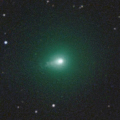
|
Third interstellar object in history following 1I/'Oumuamua and 2I/Borisov. The eccentricity is extremely big as 6. It approaches to Sun down to 1.38 a.u. in late October. Now it is 11.8 mag (Sept. 24, Michael Jager). It brightens up to 11 mag, but it will turn to fade out rapidly after that. It will be unobservable in October. But it will be observable again in November.
Date(TT) R.A. (2000) Decl. Delta r Elong. m1 Best Time(A, h)
Sept.27 14 33.28 -11 23.2 2.513 1.801 35 12.6 19:14 ( 73, 4)
Oct. 4 14 19.70 -10 31.5 2.488 1.645 25 12.1 19:03 ( 78, -1)
|
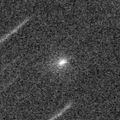
|
It brightened very rapidly. Now it is 14.4 mag (Sept. 17, Ken-ichi Kadota). It will fade out rapidly after this. It will be fainter than 18 mag in November. In the Northern Hemisphere, it will be unobservable in October. In the Southern Hemisphere, it will never be observable after this.
Date(TT) R.A. (2000) Decl. Delta r Elong. m1 Best Time(A, h)
Sept.27 10 39.04 2 52.2 1.242 0.524 24 12.3 4:27 (269, 4)
Oct. 4 11 16.74 -3 44.1 1.358 0.549 20 13.0 4:33 (274, -1)
|
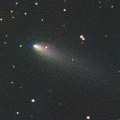
|
Now it is brighter than originally expected. Now it is 13.6 mag (Sept. 23, Osamu Miyazaki). It stays 13 mag for a while. It stays observable in good condition. It is expected to brighten up to 12 mag and to be observable in good condition from autumn to winter.
Date(TT) R.A. (2000) Decl. Delta r Elong. m1 Best Time(A, h)
Sept.27 4 13.68 -0 27.7 1.544 2.222 120 12.9 3:51 ( 0, 55)
Oct. 4 4 15.69 -0 6.6 1.467 2.206 125 12.8 3:26 ( 0, 55)
|

|
Now it is 13.9 mag (Sept. 23, Osamu Miyazaki). It stays 14 mag for a while. In the Northern Hemisphere, it stays observable in good condition. It locates somewhat low in the Southern Hemisphere.
Date(TT) R.A. (2000) Decl. Delta r Elong. m1 Best Time(A, h)
Sept.27 3 36.04 26 10.2 3.188 3.858 125 13.4 3:14 ( 0, 81)
Oct. 4 3 36.28 26 21.1 3.123 3.867 132 13.3 2:47 ( 0, 81)
|
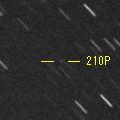
|
It is expected to brighten up to 8 mag from late autumn to early winter. Now it is 17.2 mag (Sept. 17, ATLAS South Africa). It brightens up to 8.5 mag, but it will turn to fade out rapidly after that. It will be unobservable in October in the Northern Hemisphere, or in November in the Southern Hemisphere. But it will be observable again in November in the Northern Hemisphere, or in December in the Southern Hemisphere. It is much fainter than this ephemeris recently.
Date(TT) R.A. (2000) Decl. Delta r Elong. m1 Best Time(A, h)
Sept.27 18 40.49 -41 58.2 0.587 1.196 93 14.0 19:14 ( 11, 12)
Oct. 4 18 20.88 -41 56.4 0.567 1.095 83 13.4 19:03 ( 18, 10)
|
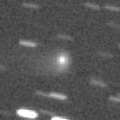
|
It is expected to brighten up to 13 mag in early summer in 2026. Now it is 14.4 mag (Sept. 12, Andrew Pearce). It stays 14 mag for a while. It will be getting lower gradually after this, and it will be unobservable in January in the Northern Hemisphere, or in November in the Southern Hemisphere. But it will be observable again in January in the Northern Hemisphere.
Date(TT) R.A. (2000) Decl. Delta r Elong. m1 Best Time(A, h)
Sept.27 19 36.71 12 35.6 3.531 3.994 110 14.3 19:14 ( 2, 68)
Oct. 4 19 29.97 10 52.8 3.616 3.967 103 14.3 19:03 ( 16, 65)
|
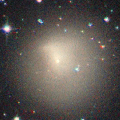
|
In the Northern Hemisphere, it will be unobservable in October. But it will be observable again in October. In the Southern Hemisphere, it is not observable now, but it will appear in October.
Date(TT) R.A. (2000) Decl. Delta r Elong. m1 Best Time(A, h)
Sept.27 10 55.05 2 40.5 7.228 6.296 20 14.3 4:27 (267, 0)
Oct. 4 10 59.54 2 7.5 7.183 6.297 25 14.3 4:33 (272, 6)
|

|
Now it is 14.6 mag (Sept. 7, Ken-ichi Kadota). It stays 15 mag for a while. It will be unobservable in October in the Southern Hemisphere, or in November in the Northern Hemisphere. But it will be observable again in January in the Southern Hemisphere, or in December in the Northern Hemisphere.
Date(TT) R.A. (2000) Decl. Delta r Elong. m1 Best Time(A, h)
Sept.27 15 35.05 -1 0.3 6.360 5.771 50 14.4 19:14 ( 71, 23)
Oct. 4 15 39.88 -1 5.4 6.458 5.797 45 14.4 19:03 ( 73, 20)
|

|
Now it is 15.7 mag (Sept. 19, Francois Kugel). It stays 15 mag for a while. In the Northern Hemisphere, it stays observable in good condition. It locates somewhat low in the Southern Hemisphere.
Date(TT) R.A. (2000) Decl. Delta r Elong. m1 Best Time(A, h)
Sept.27 8 51.89 18 52.3 6.012 5.477 53 14.8 4:27 (270, 34)
Oct. 4 8 57.18 18 58.3 5.921 5.479 59 14.7 4:33 (274, 40)
|
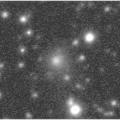
|
It will brighten up to 13 mag in 2026. Now it is 15.0 mag (Sept. 11, Andrew Pearce). It stays 15 mag for a while. It will be getting lower gradually after this, and it will be unobservable in January in the Northern Hemisphere, or in November in the Southern Hemisphere. But it will be observable again in January in the Northern Hemisphere.
Date(TT) R.A. (2000) Decl. Delta r Elong. m1 Best Time(A, h)
Sept.27 18 31.07 -11 31.5 5.119 5.282 93 15.0 19:14 ( 22, 41)
Oct. 4 18 31.29 -11 6.3 5.196 5.244 87 15.0 19:03 ( 27, 40)
|
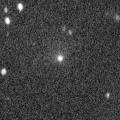
|
Very large comet. It is expected to brighten up to 13 mag in 2031. Now it is 15.0 mag (Aug. 31, Andrew Pearce). It stays 15 mag for a while. In the Northern Hemisphere, it is not observable now. In the Southern Hemisphere, it stays observable in good condition. In the Northern Hemisphere, it is not observable until 2030.
Date(TT) R.A. (2000) Decl. Delta r Elong. m1 Best Time(A, h)
Sept.27 5 42.10 -71 21.5 14.650 14.703 91 15.0 4:27 (356,-17)
Oct. 4 5 42.76 -71 51.2 14.641 14.681 90 15.0 4:33 (359,-17)
|

|
Now it is 16.5 mag (Apr. 7, Alfons Diepvens). It stays 15 mag for a while. In the Northern Hemisphere, it will be getting higher gradually. It locates somewhat low in the Southern Hemisphere. But it will become high in winter.
Date(TT) R.A. (2000) Decl. Delta r Elong. m1 Best Time(A, h)
Sept.27 9 22.16 8 37.4 3.095 2.474 43 15.0 4:27 (276, 23)
Oct. 4 9 33.80 7 22.9 3.043 2.482 47 15.0 4:33 (280, 26)
|
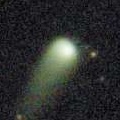
|
It was observed at 12-13 mag for a long time in 2024. Now it is 15.3 mag (Sept. 23, ATLAS-MLO, Mauna Loa). Fading slowly. In the Northern Hemisphere, it stays observable in good condition. In the Southern Hemisphere, it will be unobservable in December. But it will be observable again in October.
Date(TT) R.A. (2000) Decl. Delta r Elong. m1 Best Time(A, h)
Sept.27 23 33.33 53 50.4 4.262 4.931 127 15.0 23:06 (180, 71)
Oct. 4 23 20.04 52 23.3 4.278 4.970 129 15.1 22:26 (180, 73)
|

|
Now it is 17.7 mag (July 24, Thomas Lehmann). It will brighten rapidly after this. Now it is not observable. It will appear in January in the Southern Hemisphere, or in December in the Northern Hemisphere.
Date(TT) R.A. (2000) Decl. Delta r Elong. m1 Best Time(A, h)
Sept.27 12 55.75 -3 57.4 3.174 2.197 10 15.7 19:14 ( 93,-11)
Oct. 4 13 8.78 -5 25.3 3.139 2.151 7 15.4 19:03 ( 92,-13)
|
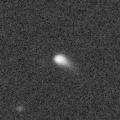
|
Now it is 15.6 mag (Sept. 7, ATLAS-MLO, Mauna Loa). It stays 15 mag for a while. It stays extremely low in the Northern Hemisphere. In the Southern Hemisphere, it stays observable in good condition. It is expected to brighten up to 12 mag in winter between 2026 and 2027.
Date(TT) R.A. (2000) Decl. Delta r Elong. m1 Best Time(A, h)
Sept.27 3 21.76 -44 27.5 5.683 6.216 117 15.7 2:59 ( 0, 11)
Oct. 4 3 19.55 -44 59.3 5.624 6.174 119 15.6 2:29 ( 0, 10)
|
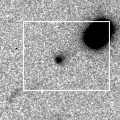
|
It is expected to brighten up to 13.5 mag and to be observable in good condition in 2026 spring. Now it is 16.8 mag (Aug. 12, ATLAS South Africa). Brightening slowly. In the Northern Hemisphere, it is not observable now, but it will appear in January. It locates somewhat low in the Southern Hemisphere. But it will become high in winter.
Date(TT) R.A. (2000) Decl. Delta r Elong. m1 Best Time(A, h)
Sept.27 12 46.94 -63 59.4 2.452 2.184 62 15.8 19:14 ( 32,-36)
Oct. 4 13 12.22 -61 35.6 2.488 2.129 57 15.8 19:03 ( 35,-35)
|
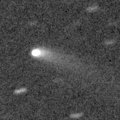
|
Now it is 15.5 mag (Sept. 3, Michael Jager). Fading slowly. It stays observable in good condition.
Date(TT) R.A. (2000) Decl. Delta r Elong. m1 Best Time(A, h)
Sept.27 22 47.26 -11 10.9 1.873 2.813 155 15.8 22:21 ( 0, 44)
Oct. 4 22 43.37 -10 53.7 1.916 2.811 147 15.9 21:50 ( 0, 44)
|

|
It brightened up to 12.7 mag in 2024 summer (Aug. 7, 2024, Thomas Lehmann). Now it is 15.7 mag (Sept. 23, ATLAS-MLO, Mauna Loa). Fading slowly. In the Northern Hemisphere, it stays observable in good condition. In the Southern Hemisphere, it will never be observable after this.
Date(TT) R.A. (2000) Decl. Delta r Elong. m1 Best Time(A, h)
Sept.27 22 35.16 58 13.9 3.468 4.064 120 15.9 22:09 (180, 67)
Oct. 4 22 28.75 57 43.9 3.517 4.118 120 16.0 21:35 (180, 67)
|
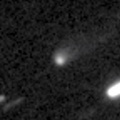
|
Now it is 15.7 mag (Sept. 14, J. Tapioles). Fading slowly. It will be unobservable in January.
Date(TT) R.A. (2000) Decl. Delta r Elong. m1 Best Time(A, h)
Sept.27 18 36.13 -31 28.3 2.728 2.970 93 15.9 19:14 ( 14, 22)
Oct. 4 18 43.17 -31 13.8 2.827 2.977 88 16.0 19:03 ( 17, 22)
|
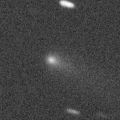
|
It brightened up to 12.1 mag in early summer (June 10, Taras Prystavski). Now it is 15.5 mag (Sept. 14, Catalina Sky Survey). Fading slowly. It will be fainter than 18 mag in January. In the Northern Hemisphere, it stays observable in good condition. It locates somewhat low in the Southern Hemisphere. But it will become high in autumn.
Date(TT) R.A. (2000) Decl. Delta r Elong. m1 Best Time(A, h)
Sept.27 8 19.75 14 4.1 2.229 1.934 60 16.1 4:27 (280, 39)
Oct. 4 8 30.87 13 40.8 2.213 1.992 64 16.2 4:33 (285, 43)
|

|
It will brighten up to 12 mag in 2026 summer. Now it is 16.2 mag (Sept. 18, Francois Kugel). Brightening slowly. In the Northern Hemisphere, it stays observable in good condition. In the Southern Hemisphere, it will be getting lower gradually after this, and it will be unobservable in January.
Date(TT) R.A. (2000) Decl. Delta r Elong. m1 Best Time(A, h)
Sept.27 19 51.50 -13 22.6 2.321 2.869 113 16.2 19:27 ( 0, 42)
Oct. 4 19 53.50 -13 36.4 2.379 2.837 106 16.1 19:03 ( 1, 41)
|

|
Now it is 17.0 mag (Sept. 23, ATLAS-HKO, Haleakala). It stays 16 mag for a while. In the Northern Hemisphere, it stays observable in good condition. In the Southern Hemisphere, it will be unobservable in January.
Date(TT) R.A. (2000) Decl. Delta r Elong. m1 Best Time(A, h)
Sept.27 8 37.35 29 57.4 4.382 3.983 60 16.4 4:27 (259, 42)
Oct. 4 8 41.87 31 9.0 4.288 3.997 66 16.4 4:33 (261, 48)
|

|
Now it is 16.2 mag (May 13, ATLAS South Africa). It stays 16 mag for a while. In the Northern Hemisphere, it will be getting higher gradually. In the Southern Hemisphere, it stays observable in good condition.
Date(TT) R.A. (2000) Decl. Delta r Elong. m1 Best Time(A, h)
Sept.27 8 40.06 -10 48.5 7.110 6.569 53 16.4 4:27 (299, 19)
Oct. 4 8 43.69 -10 60.0 7.035 6.571 58 16.4 4:33 (305, 24)
|
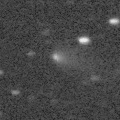
|
It brightened very rapidly, and it became brighter than expected. Now it is 15.9 mag (Sept. 20, Andrew Pearce). Fading slowly. It will be fainter than 18 mag in January. It stays observable in good condition.
Date(TT) R.A. (2000) Decl. Delta r Elong. m1 Best Time(A, h)
Sept.27 0 38.97 -4 11.4 2.416 3.410 171 16.5 0:17 ( 0, 51)
Oct. 4 0 34.76 -4 42.3 2.427 3.419 171 16.5 23:41 ( 0, 50)
|

|
Now it is 16.0 mag (Sept. 12, Alfons Diepvens). It stays 17 mag for a while. In the Northern Hemisphere, it stays observable in good condition. In the Southern Hemisphere, it will never be observable after this.
Date(TT) R.A. (2000) Decl. Delta r Elong. m1 Best Time(A, h)
Sept.27 13 32.44 63 9.3 4.680 4.375 66 16.5 19:14 (148, 30)
Oct. 4 13 50.57 63 13.0 4.647 4.385 68 16.5 19:03 (148, 30)
|
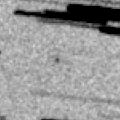
|
It will brighten up to 8 mag in winter, and will be observable in good condition. Now it is 18.4 mag (Sept. 18, W. Hasubick). It will brighten rapidly after this. In the Northern Hemisphere, it stays observable in good condition. It locates somewhat low in the Southern Hemisphere. But it will become high in winter.
Date(TT) R.A. (2000) Decl. Delta r Elong. m1 Best Time(A, h)
Sept.27 6 19.06 18 51.5 1.452 1.754 89 17.0 4:27 (304, 64)
Oct. 4 6 38.16 19 13.1 1.341 1.696 91 16.5 4:33 (309, 67)
|
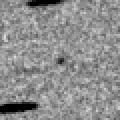
|
Now it is 16.7 mag (Sept. 18, Francois Kugel). It stays 17 mag for a while. It stays observable in good condition.
Date(TT) R.A. (2000) Decl. Delta r Elong. m1 Best Time(A, h)
Sept.27 19 50.41 -16 34.6 1.540 2.136 112 16.7 19:26 ( 0, 39)
Oct. 4 19 56.10 -16 11.5 1.596 2.119 107 16.6 19:04 ( 0, 39)
|
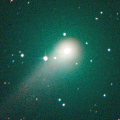
|
It was observed at 9-10 mag for a long time in 2023. It is fading very slowly. Now it is 16.4 mag (Aug. 29, ATLAS Chile). It stays 17 mag for a while. In the Northern Hemisphere, it will never be observable after this. In the Southern Hemisphere, it stays observable in good condition.
Date(TT) R.A. (2000) Decl. Delta r Elong. m1 Best Time(A, h)
Sept.27 18 57.68 -71 10.7 8.288 8.384 92 16.9 19:14 ( 3,-16)
Oct. 4 18 54.88 -70 31.7 8.422 8.435 87 17.0 19:03 ( 5,-16)
|
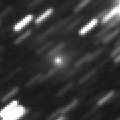
|
Very far object. Now it is 17.4 mag (July 26, ATLAS South Africa). It stays 17 mag for a while. In the Northern Hemisphere, it is not observable now, but it will appear in November. In the Southern Hemisphere, it stays observable in good condition.
Date(TT) R.A. (2000) Decl. Delta r Elong. m1 Best Time(A, h)
Sept.27 0 49.94 -57 44.9 10.393 10.933 120 17.0 0:28 ( 0, -3)
Oct. 4 0 44.36 -57 40.3 10.438 10.945 118 17.0 23:50 ( 0, -3)
|
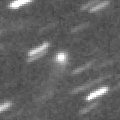
|
Now it is 17.1 mag (Aug. 21, Yasukazu Ikari). It stays 17 mag for a while. It will be unobservable in November. But it will be observable again in January in the Southern Hemisphere, or in December in the Northern Hemisphere.
Date(TT) R.A. (2000) Decl. Delta r Elong. m1 Best Time(A, h)
Sept.27 15 51.12 -11 11.9 7.033 6.506 54 17.0 19:14 ( 60, 19)
Oct. 4 15 52.74 -10 56.3 7.121 6.499 48 17.0 19:03 ( 63, 16)
|
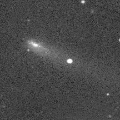
|
Now it is 16.2 mag (Aug. 30, Thomas Lehmann). Fading gradually. It will be fainter than 18 mag in November. It stays observable in good condition.
Date(TT) R.A. (2000) Decl. Delta r Elong. m1 Best Time(A, h)
Sept.27 4 2.68 4 33.3 1.855 2.542 122 17.0 3:40 ( 0, 60)
Oct. 4 4 1.81 4 9.6 1.817 2.571 129 17.2 3:12 ( 0, 59)
|

|
Now it is 17.6 mag (Sept. 19, Alfons Diepvens). It stays 17 mag for a while. In the Northern Hemisphere, it stays observable in good condition. In the Southern Hemisphere, it will never be observable after this.
Date(TT) R.A. (2000) Decl. Delta r Elong. m1 Best Time(A, h)
Sept.27 7 47.79 74 15.9 5.122 5.137 85 17.1 4:27 (196, 45)
Oct. 4 8 5.18 75 44.4 5.050 5.130 88 17.0 4:33 (193, 45)
|
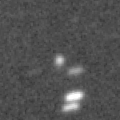
|
Brightening rapidly. It is expected to brighten up to 13 mag from 2027 to 2028. Now it is 16.8 mag (Sept. 1, Ken-ichi Kadota). It stays 17 mag for a while. In the Northern Hemisphere, it stays observable in good condition. In the Southern Hemisphere, it will be getting lower gradually after this, and it will be unobservable in December.
Date(TT) R.A. (2000) Decl. Delta r Elong. m1 Best Time(A, h)
Sept.27 21 48.73 23 39.8 6.575 7.356 138 17.1 21:23 ( 0, 79)
Oct. 4 21 44.51 23 23.9 6.589 7.316 133 17.1 20:51 ( 0, 78)
|

|
Now it is 17.5 mag (Sept. 6, ATLAS-MLO, Mauna Loa). It stays 17 mag for a while. In the Northern Hemisphere, it stays observable in good condition. It stays extremely low in the Southern Hemisphere.
Date(TT) R.A. (2000) Decl. Delta r Elong. m1 Best Time(A, h)
Sept.27 5 10.36 47 7.3 3.547 3.879 101 17.2 4:27 (197, 77)
Oct. 4 5 13.51 48 2.2 3.454 3.872 107 17.1 4:24 (180, 77)
|
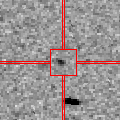
|
Now it is 17.2 mag (Sept. 17, Ken-ichi Kadota). It stays 17 mag for a while. It stays observable in good condition.
Date(TT) R.A. (2000) Decl. Delta r Elong. m1 Best Time(A, h)
Sept.27 22 23.22 -23 58.4 1.322 2.206 142 17.2 21:58 ( 0, 31)
Oct. 4 22 19.63 -23 16.6 1.341 2.176 136 17.1 21:27 ( 0, 32)
|
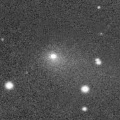
|
It brightened rapidly up to 14.6 mag in winter (Jan. 31, Thomas Lehmann). Now it is 16.9 mag (Sept. 16, ATLAS-HKO, Haleakala). Fading gradually. It will be fainter than 18 mag in November. It stays extremely low in the Northern Hemisphere. In the Southern Hemisphere, it stays observable in good condition.
Date(TT) R.A. (2000) Decl. Delta r Elong. m1 Best Time(A, h)
Sept.27 3 13.21 -39 17.4 2.271 2.930 122 17.1 2:51 ( 0, 16)
Oct. 4 3 7.32 -42 15.8 2.330 2.991 122 17.3 2:17 ( 0, 13)
|
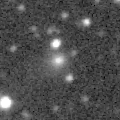
|
Now it is 17.0 mag (Sept. 17, Ken-ichi Kadota). Fading slowly. It will be fainter than 18 mag in December. In the Northern Hemisphere, it stays observable in good condition. In the Southern Hemisphere, it will be getting lower gradually.
Date(TT) R.A. (2000) Decl. Delta r Elong. m1 Best Time(A, h)
Sept.27 19 46.54 -15 6.6 4.608 5.068 111 17.1 19:22 ( 0, 40)
Oct. 4 19 48.03 -14 51.9 4.736 5.095 105 17.2 19:03 ( 2, 40)
|

|
Now it is 17.2 mag (Mar. 6, ATLAS South Africa). It stays 17 mag for a while. It locates somewhat low in the Northern Hemisphere. In the Southern Hemisphere, it will be getting higher gradually.
Date(TT) R.A. (2000) Decl. Delta r Elong. m1 Best Time(A, h)
Sept.27 9 13.95 -16 1.4 5.075 4.447 46 17.2 4:27 (297, 9)
Oct. 4 9 20.11 -17 7.0 5.019 4.449 50 17.2 4:33 (302, 13)
|
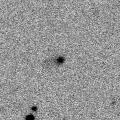
|
It continues brightening even after the perihelion passage. Now it is 17.0 mag (Sept. 23, ATLAS Chile). It stays 18 mag for a while. In the Northern Hemisphere, it will never be observable after this. In the Southern Hemisphere, it stays observable in good condition.
Date(TT) R.A. (2000) Decl. Delta r Elong. m1 Best Time(A, h)
Sept.27 1 47.63 -68 24.2 5.245 5.640 108 17.3 1:26 ( 0,-13)
Oct. 4 1 26.77 -68 49.5 5.299 5.664 106 17.3 0:38 ( 0,-14)
|

|
Now it is 17.5 mag (Sept. 23, Ken-ichi Kadota). It stays 18 mag for a while. In the Northern Hemisphere, it stays observable in good condition. In the Southern Hemisphere, it will never be observable after this.
Date(TT) R.A. (2000) Decl. Delta r Elong. m1 Best Time(A, h)
Sept.27 3 17.57 82 42.5 1.722 2.089 96 17.4 3:03 (180, 42)
Oct. 4 22 24.68 85 24.6 1.670 2.063 98 17.3 21:04 (180, 40)
|
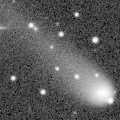
|
Now it is 17.1 mag (Sept. 2, Andrew Pearce). It stays 18 mag for a while. It stays extremely low in the Northern Hemisphere. In the Southern Hemisphere, it stays observable in good condition.
Date(TT) R.A. (2000) Decl. Delta r Elong. m1 Best Time(A, h)
Sept.27 5 57.99 -43 8.6 8.151 8.245 91 17.3 4:27 (347, 10)
Oct. 4 5 55.55 -43 53.6 8.144 8.289 94 17.3 4:33 (354, 11)
|

|
Now it is 17.3 mag (Sept. 15, Catalina Sky Survey). It stays 17 mag for a while. In the Northern Hemisphere, it stays observable in good condition. It stays extremely low in the Southern Hemisphere.
Date(TT) R.A. (2000) Decl. Delta r Elong. m1 Best Time(A, h)
Sept.27 9 18.62 21 38.1 2.555 2.036 48 17.4 4:27 (264, 30)
Oct. 4 9 33.15 21 15.3 2.528 2.072 52 17.3 4:33 (267, 34)
|
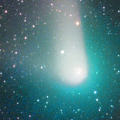
|
It brightened up to 8 mag from 2022 summer to 2023 spring. Now it is 16.9 mag (Sept. 5, Alfons Diepvens). It stays 18 mag for a while. In the Northern Hemisphere, it stays observable in good condition. It locates somewhat low in the Southern Hemisphere.
Date(TT) R.A. (2000) Decl. Delta r Elong. m1 Best Time(A, h)
Sept.27 6 20.14 28 18.8 9.582 9.622 89 17.3 4:27 (283, 70)
Oct. 4 6 19.85 28 31.3 9.511 9.672 96 17.3 4:33 (294, 76)
|

|
It brightened up to -3 mag due to the forward scattering in the SOHO coronagraph images (Oct. 9, 2024, Q.-c. Zhang, Charles S. Morris). It became a great comet of 0 mag on the ground. Now it is 17.0 mag (Sept. 7, Ken-ichi Kadota). Fading slowly. It will be fainter than 18 mag in October. In the Northern Hemisphere, it will be getting lower gradually. It locates somewhat low in the Southern Hemisphere.
Date(TT) R.A. (2000) Decl. Delta r Elong. m1 Best Time(A, h)
Sept.27 17 54.07 17 18.6 5.228 5.249 85 17.4 19:14 ( 59, 61)
Oct. 4 17 54.70 16 26.4 5.392 5.320 80 17.5 19:03 ( 63, 57)
|
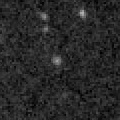
|
Now it is 17.7 mag (Aug. 30, J. Linder). Brightening slowly. In the Northern Hemisphere, it stays observable in good condition. In the Southern Hemisphere, it is not observable now.
Date(TT) R.A. (2000) Decl. Delta r Elong. m1 Best Time(A, h)
Sept.27 11 3.78 69 44.5 4.455 4.257 72 17.5 4:27 (204, 31)
Oct. 4 11 8.53 69 41.3 4.363 4.225 75 17.5 4:33 (205, 34)
|
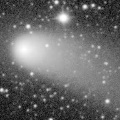
|
It brightened up to 9.6 mag from February to March in 2024 (Feb. 25, 2024, Thomas Lehmann). Now it is 17.9 mag (Sept. 17, Ken-ichi Kadota). Fading slowly. It will be fainter than 18 mag in November. In the Northern Hemisphere, it stays observable in good condition. It stays extremely low in the Southern Hemisphere.
Date(TT) R.A. (2000) Decl. Delta r Elong. m1 Best Time(A, h)
Sept.27 23 2.69 42 27.8 5.914 6.672 136 17.6 22:37 (180, 82)
Oct. 4 22 59.05 41 42.5 5.972 6.731 136 17.7 22:06 (180, 83)
|
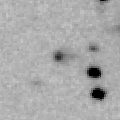
|
Now it is 17.8 mag (Sept. 17, Francois Kugel). It stays 18 mag for a while. It will be getting lower gradually after this, and it will be unobservable in November in the Southern Hemisphere, or in December in the Northern Hemisphere. But it will be observable again in January in the Northern Hemisphere.
Date(TT) R.A. (2000) Decl. Delta r Elong. m1 Best Time(A, h)
Sept.27 17 1.83 6 57.2 5.300 5.085 72 17.7 19:14 ( 61, 44)
Oct. 4 17 6.65 6 8.7 5.368 5.071 67 17.7 19:03 ( 63, 42)
|
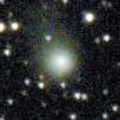
|
It brightened up to 12.1 mag in 2023 spring (May 20, 2023, Jose Guilherme de S. Aguiar). Now it is 17.4 mag (Mar. 25, ATLAS South Africa). It stays 18 mag for a while. It stays observable in good condition.
Date(TT) R.A. (2000) Decl. Delta r Elong. m1 Best Time(A, h)
Sept.27 6 42.58 -18 50.0 8.142 8.077 82 17.7 4:27 (329, 30)
Oct. 4 6 42.50 -19 8.5 8.100 8.124 87 17.7 4:33 (338, 33)
|
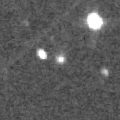
|
Now it is 17.5 mag (Sept. 23, ATLAS-MLO, Mauna Loa). It stays 18 mag for a while. In the Northern Hemisphere, it will be getting lower gradually. In the Southern Hemisphere, it will never be observable after this.
Date(TT) R.A. (2000) Decl. Delta r Elong. m1 Best Time(A, h)
Sept.27 16 36.28 46 49.9 5.351 5.178 74 17.7 19:14 (123, 54)
Oct. 4 16 40.43 44 58.8 5.401 5.192 72 17.7 19:03 (120, 52)
|
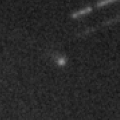
|
Now it is 17.9 mag (Sept. 23, ATLAS Chile). It stays 18 mag for a while. It stays extremely low in the Northern Hemisphere. In the Southern Hemisphere, it stays observable in good condition.
Date(TT) R.A. (2000) Decl. Delta r Elong. m1 Best Time(A, h)
Sept.27 20 33.89 -54 41.0 2.493 2.961 108 17.7 20:09 ( 0, 0)
Oct. 4 20 27.34 -55 42.5 2.578 2.941 101 17.7 19:35 ( 0, -1)
|

|
Now it is 17.7 mag (June 26, ATLAS Chile). It stays 18 mag for a while. It will be getting higher gradually.
Date(TT) R.A. (2000) Decl. Delta r Elong. m1 Best Time(A, h)
Sept.27 9 15.01 -7 57.2 4.383 3.742 45 17.7 4:27 (291, 14)
Oct. 4 9 18.10 -7 36.4 4.316 3.754 50 17.7 4:33 (296, 20)
|
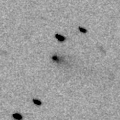
|
Now it is 17.3 mag (Aug. 31, Michael Jager). Fading gradually. It will be fainter than 18 mag in October. It stays observable in good condition.
Date(TT) R.A. (2000) Decl. Delta r Elong. m1 Best Time(A, h)
Sept.27 0 26.42 4 58.3 1.587 2.588 175 17.8 0:05 ( 0, 60)
Oct. 4 0 21.58 4 20.0 1.609 2.608 175 17.9 23:28 ( 0, 59)
|

|
It brightened up to 11 mag in the SWAN images in early spring (Jan. 27, Vladimir Bezugly). It stays 18 mag for a while. It will be getting higher gradually.
Date(TT) R.A. (2000) Decl. Delta r Elong. m1 Best Time(A, h)
Sept.27 9 11.68 -9 6.4 3.029 2.441 45 17.8 4:27 (292, 14)
Oct. 4 9 20.48 -10 17.2 3.029 2.500 49 17.9 4:33 (297, 18)
|
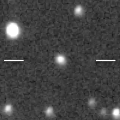
|
Although it is around 20 mag usually, now it is bright in outburst. Now it is 17.2 mag (Sept. 17, ATLAS-HKO, Haleakala). It stays 18 mag for a while. In the Northern Hemisphere, it stays observable in good condition. It stays extremely low in the Southern Hemisphere.
Date(TT) R.A. (2000) Decl. Delta r Elong. m1 Best Time(A, h)
Sept.27 3 13.39 38 8.1 8.296 8.908 124 17.8 2:51 (180, 87)
Oct. 4 3 11.82 38 18.0 8.205 8.899 131 17.8 2:22 (180, 87)
|

|
Now it is 17.8 mag (Mar. 17, ATLAS Chile). It stays 18 mag for a while. It stays observable in good condition.
Date(TT) R.A. (2000) Decl. Delta r Elong. m1 Best Time(A, h)
Sept.27 7 44.89 -8 33.6 4.449 4.165 67 17.9 4:27 (308, 30)
Oct. 4 7 49.90 -9 19.2 4.376 4.175 71 17.9 4:33 (315, 34)
|

|
Now it is 18.1 mag (Sept. 17, ATLAS-HKO, Haleakala). It stays 18 mag for a while. It stays observable in good condition.
Date(TT) R.A. (2000) Decl. Delta r Elong. m1 Best Time(A, h)
Sept.27 6 57.16 10 10.3 4.168 4.108 79 17.9 4:27 (303, 52)
Oct. 4 7 1.18 9 37.7 4.076 4.117 85 17.9 4:33 (313, 56)
|
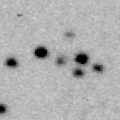
|
Now it is 17.8 mag (Sept. 22, ATLAS South Africa). It stays 18 mag for a while. It locates somewhat low in the Northern Hemisphere. In the Southern Hemisphere, it stays observable in good condition.
Date(TT) R.A. (2000) Decl. Delta r Elong. m1 Best Time(A, h)
Sept.27 19 40.17 -22 25.7 3.642 4.084 109 17.9 19:15 ( 0, 33)
Oct. 4 19 42.19 -22 9.6 3.755 4.096 102 18.0 19:03 ( 4, 33)
|
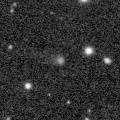
|
Now it is 18.1 mag (Sept. 22, Francois Kugel). It stays 18 mag for a while. In the Northern Hemisphere, it will be getting lower gradually. In the Southern Hemisphere, it will never be observable after this.
Date(TT) R.A. (2000) Decl. Delta r Elong. m1 Best Time(A, h)
Sept.27 15 23.53 41 4.0 5.545 5.125 60 17.9 19:14 (117, 40)
Oct. 4 15 25.13 39 40.8 5.589 5.132 58 17.9 19:03 (116, 37)
|
|
![]()
 C/2019 U5 ( PanSTARRS )
C/2019 U5 ( PanSTARRS ) 164P/Christensen
164P/Christensen C/2017 K2 ( PanSTARRS )
C/2017 K2 ( PanSTARRS ) C/2023 A3 ( Tsuchinshan-ATLAS )
C/2023 A3 ( Tsuchinshan-ATLAS ) C/2025 J1 ( Borisov )
C/2025 J1 ( Borisov ) C/2021 S3 ( PanSTARRS )
C/2021 S3 ( PanSTARRS ) C/2024 G4 ( PanSTARRS )
C/2024 G4 ( PanSTARRS ) C/2020 K1 ( PanSTARRS )
C/2020 K1 ( PanSTARRS ) C/2024 N3 ( Sarneczky )
C/2024 N3 ( Sarneczky ) C/2025 L2 ( MAPS )
C/2025 L2 ( MAPS ) C/2024 X2 ( ATLAS )
C/2024 X2 ( ATLAS ) 486P/2024 H1 ( Leonard )
486P/2024 H1 ( Leonard ) 21P/Giacobini-Zinner
21P/Giacobini-Zinner C/2023 RS61 ( PanSTARRS )
C/2023 RS61 ( PanSTARRS ) 242P/Spahr
242P/Spahr 276P/Vorobjov
276P/Vorobjov 491P/2024 K2 ( Spacewatch-PanSTARRS )
491P/2024 K2 ( Spacewatch-PanSTARRS ) C/2023 V1 ( Lemmon )
C/2023 V1 ( Lemmon )![]()


























































